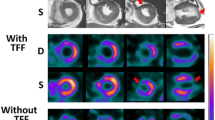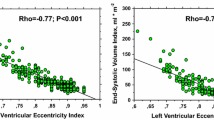Abstract
Background
Although the myocardial gated single photon emission computed tomography (SPECT) technique makes it possible to assess concurrent myocardial perfusion and function, quantitative methods for analyzing and displaying gated SPECT data in 2- and 3-dimensional presentations for regional and global cardiac assessment have not been established.
Methods and Results
We have developed an automated quantitative method for assessing perfusion and function by means of technetium-99m sestamibi gated SPECT with a computerized technique combining count-based and image-based methods. We have examined its validity in 91 patients by comparing its results with those of conventional techniques: contrast left ventriculography and radionuclide angiocardiography. In addition to color-scale displays of regional function, simultaneous 3-dimensional presentations of regional wall motion and perfusion have been produced. High reproducibility of gated SPECT analysis with this algorithm was demonstrated; interoperator errors (%CV) were 2.6% to 5.5%, and good intraobserver reproducibility was confirmed by means of high correlation coefficients (0.954 to 0.989). Left ventricular volumes assessed by means of contrast left ventriculography and by means of the gated SPECT technique showed significant correlations (left ventricular end-diastolic volume, y = 1.01x - 9.7, r = 0.845, P < .001, standard errors of the estimate [SEE] = 14 mL; left ventricular end-systolic volume, y = 1.03x - 1.4, r = 0.902, P < .001, SEE = 6 mL). Left ventricular ejection fraction determined by means of gated SPECT with the new algorithm closely correlated with that determined by means of radionuclide ventriculography (y = 1.05x - 0.6, r = 0.891, P < .001, SEE = 3%). These parameters quantified by means of the present method correlated closely with those derived from the QGS program (r = 0.926 to 0.987).
Conclusion
In comparison with conventional techniques, myocardial gated SPECT with automated quantitative analysis provides accurate and reproducible data for global and regional function. Quantitative concurrent assessment of myocardial perfusion and function by using 2- and 3-dimensional representations appears to be superior to other modalities and to contribute to nuclear cardiology practice.
Similar content being viewed by others
References
DePuey GE, Nichols K, Dobrinsky C. Left ventricular ejection fraction assessed from gated technetium-99m-sestamibi SPECT. J Nucl Med 1993;34:1871–6.
Germano G, Kiat H, Kavanagh PB, Moriel M, Mazzanti M, Su HT, et al. Automatic quantification of ejection fraction from gated myocardial perfusion SPECT. J Nucl Med 1995;36:2138–47.
Nichols K, DePuey GE, Rozanski A. Automation of gated tomographic left ventricular ejection fraction. J Nucl Cardiol 1996;3: 475–82.
Berman DS, Germano G. Evaluation of ventricular ejection fraction, wall motion, wall thickening, and other parameters with gated myocardial perfusion single-photon emission computed tomography. J Nucl Cardiol 1997;4:S169–71.
Snapper HJ, Shea NL, Konstam MA, Oates E, Udelson JE. Combined analysis of resting regional wall thickening and stress perfusion with electrocardiographic-gated technetium 99m-labeled sestamibi single photon emission computed tomography: prediction of stress defect reversibility. J Nucl Cardiol 1997;4:3–10.
Anagnostopoulos C, Gunning MG, Pennell DJ, Laney R, Proukakis H, Underwood SR. Regional myocardial motion and thickening assessed at rest by ECG-gated 99mTc-MIBI emission tomography and by magnetic resonance imaging. Eur J Nucl Med 1996;23:909–16.
DePuey GE, Rozanski A. Using gated technetium-99m-sestamibi SPECT to characterize fixed myocardial defects as infarct or artifact. J Nucl Med 1995;36:952–5.
Katagiri Y, Odawara Y, Kuroda M, Fujiwara Y, Oomoto H, Nakata T, et al. Regional and global assessment of left ventricular function and perfusion by automated myocardial gated SPECT [abstract]. Eur J Nucl Med 1998;25:1191.
Katagiri Y, Odawara Y, Kuroda M, Sakuta K, Nakata T, Eguchi M, et al. p-FAST program for gated SPECT imaging: three-dimensional displays of regional wall motion and perfusion and wall thickness assessment [abstract]. J Nucl Cardiol 1999;6:S112.
Germano G, Kavanagh PB, Kavanagh JT, Wishner SH, Berman DS, Kavanagh GJ. Repeatability of automatic left ventricular cavity volume measurements from myocardial perfusion. J Nucl Cardiol 1998;5:477–83.
Germano G, Erel J, Lewin H, Kavanagh PB, Berman DS. Automatic quantitation of regional myocardial wall motion and thickening gated technetium-99m sestamibi myocardial single-photon emission computed tomography. J Am Coll Cardiol 1997;30:1360–7.
Fukuchi K, Uehara T, Morozumi T, Tsujimura E, Hasegawa S, Yutani K, et al. Quantification of systolic count increase in technetium-99m-MIBI gated myocardial SPECT. J Nucl Med 1997;38:1067–73.
Long DT, King MA, Sheehan J. Comparative evaluation of image segmentation methods for volume quantification in SPECT. Med Phys 1992;19:483–9.
Nakata T, Noto T, Uno K, Wada A, Hikita N, Tanaka S, et al. Quantification of area and percentage of infarcted myocardium by single photon emission computed tomography with thallium-201: a comparison with serial serum CK-MB measurements. Ann Nucl Med 1989;3:1–8.
Hashimoto A, Nakata T, Tsuchihashi K, Tanaka S, Fujimori K, Iimura O. Postischemic functional recovery and BMIPP uptake after primary percutaneous transluminal coronary angioplasty in acute myocardial infarction. Am J Cardiol 1996;77:25–30.
Nakata T, Hashimoto A, Kobayashi H, Miyamoto K, Tsuchihashi K, Miura T, et al. Outcome significance of thallium-201 and iodine-123 BMIPP perfusion-metabolism mismatch in preinfarction angina. J Nucl Med 1998;39:1492–9.
Taillefer R, DePuey EG, Udelson JE, et al. Comparative diagnostic accuracy of Tl-201 and Tc-99m sestamibi SPECT imaging (perfusion and ECG-gated SPECT) in detecting coronary artery disease in women. J Am Coll Cardiol 1997;29:69–77.
Udelson JE, Coleman PS, Metherall J, Pandian NG, Gomez AR, Griffith JL, et al. Predicting recovery of severe regional ventricular dysfunction. Comparison of resting scintigraphy with 201Tl and 99mTcsestamibi. Circulation 1994;89:2552–61.
Achert AD, King MA, Dahlberg ST, Pretorius PH, LaCroix KJ, Tsui BMW. Investigation of the influence of lesion size and count level on the estimation of EF in gated SPECT perfusion imaging [abstract]. J Nucl Med 1997;38:221P.
Nichols K, DePuey GE, Krasnow N, Lefkowitz D, Rozanski A. Reliability of enhanced gated SPECT in assessing wall motion of severely hypoperfused myocardium: echocardiographic validation. J Nucl Cardiol 1998;5:387–94.
Marcassa C, Marzullo P, Parodi O, Sambuceti G, L’Abbate A. A new method for noninvasive quantification of segmental myocardial wall thickening using technetium-99m 2-methoxy-isobutyl-isonitrile scintigraphy: results in normal subjects. J Nucl Med 1990;31:1173–7.
Hoffman EJ, Huang SC, Phelps ME. Quantitation in positron emission computed tomography: 1. Effect of object size. J Comput Assist Tomogr 1979;3:299–308.
Smith WH, Kastner RJ, Calnon DA, et al. Quantitative gated single photon emission computed tomography imaging: a count-based method for display and measurement of regional and global ventricular systolic function. J Nucl Cardiol 1997;4:451–63.
Cullom SJ, Case JA, Bateman TM. Electrocardiographically gated myocardial perfusion SPECT: technical principles and quality control considerations. J Nucl Cardiol 1998;5:418–25.
Author information
Authors and Affiliations
Corresponding author
Additional information
We thank the staff of the Cardiology and Nuclear Medicine Department of Sapporo Medical University Hospital for their technical cooperation.
Rights and permissions
About this article
Cite this article
Nakata, T., Katagiri, Y., Odawara, Y. et al. Two- and three-dimensional assessments of myocardial perfusion and function by using technetium-99m sestamibi gated SPECT with a combination of count- and image-based techniques. J Nucl Cardiol 7, 623–632 (2000). https://doi.org/10.1067/mnc.2000.109271
Received:
Accepted:
Issue Date:
DOI: https://doi.org/10.1067/mnc.2000.109271




